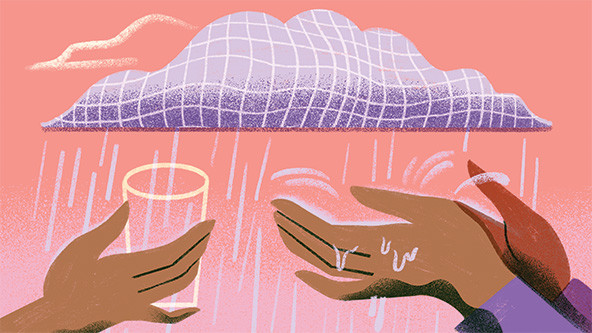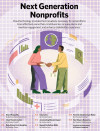 (Illustration by Vanessa Lovegrove)
(Illustration by Vanessa Lovegrove)
Nearly 800 million people worldwide lack access to clean drinking water. They are forced to rely on contaminated water sources such as streams and ponds that can cause illness and death. According to the United Nations, diseases from dirty water kill more people every year than all forms of violence, including war. Women and girls, who are most often tasked with collecting water, spend hours walking to find water instead of earning income, caring for themselves and their families, or attending school.
Next Generation Nonprofits

Cloud technology provides the innovations necessary for nonprofits to more effectively serve their constituencies, increase donor and member engagement, and enhance stakeholder experience. This supplement shares insights into how your organization can use this technology to jump-start your success. Sponsored by AWS
charity: water is a nonprofit on a mission to bring clean, safe drinking water to people in developing countries. When a clean-water project is built in a community, it brings health, economic development, education, and dignity. With the generous support of more than one million donors, in 15 years charity: water has funded 111,709 water projects in 29 countries and brought clean water to more than 15 million people.
Since our founding in 2006, we have pursued tech innovations to tackle the global water crisis and provide accountability and transparency to our work. For example, we have used Google Earth mapping technology to provide the GPS coordinates for every water project so that donors can see where their money is deployed. We were one of the first charities on Instagram, where we engaged with our supporters by sharing project photos and stories of impact, and we were the first charity to reach one million followers on Twitter. We were also an early adopter of virtual reality; we created a film that captured the 360-degree experience of gaining access to clean water for the first time.
As we’ve grown, we continue to face new challenges. One of the hardest lessons we’ve learned is about the sustainability challenges experienced by rural communities in the developing world. The reality is that some of the water systems in the remote communities we serve will break down over time due to heavy usage. When that happens, families are forced to return to contaminated water sources. Local governments have scant resources, and many villages are so remote that water systems are only checked periodically. Historically, there has been no real-time data regarding remote water systems. As a result, governments, nonprofits, and businesses have been severely limited in their efforts to keep clean water flowing.
As charity: water sought solutions to the problem of long-term sustainability of water projects, we were surprised to discover how little technological innovation had been adopted worldwide to address this massive problem. In 2012 we began looking into water management in developed economies for inspiration on how vital public services are managed. We learned that in cities like New York, Singapore, and Copenhagen technologies like the Internet of Things (IoT), remote sensing, and AI safeguard public services. We became convinced that this technology also held the potential to help those living on less than $1 per day.
charity: water set out that year to develop a first-of-its-kind sensor technology to provide real-time data on the performance of remote water systems. We believed these sensors could enable local nonprofits and governments to monitor rural water systems that serve millions of beneficiaries without needing on-site visits—saving time, money, and human resources. We also hoped the sensor data would give local governments valuable knowledge about water usage in their communities, helping them to better manage water services and plan future investments.
The first phase of the project involved a comprehensive evaluation of all commercially available options for remote-flow sensing in various industries, such as petrol or irrigation. Unfortunately, we found that no viable alternatives existed to measure the flow of water in hand pumps, so we determined that we needed to design and produce an original device. With grants from funders, including the AWS IMAGINE Grant, charity: water was able to invest in the research and development of water-sensor technology.
To start, we knew the device had to be durable and able to withstand harsh conditions and potential vandals. It needed to be something that a local technician could easily install without complicated instructions or difficult-to-find, costly tools. It needed to have a long battery life so that villagers would not have to worry about battery failure and frequent battery changes. And it needed to be able to communicate wirelessly despite unreliable wireless networks in remote locations. Most of all, it needed to be affordable and scalable.
We’ve now been able to produce the first-ever scalable remote sensor to monitor rural water points. The device is tamper-proof, easy to install, runs for 10 years without a battery change, and costs only $250—which is less than 2 percent of the cost of a new hand pump. The sensor’s wireless roaming agreement automatically offers coverage in more than 200 countries. We’ve included a pair of powerful antennas in the device that allow us to connect to cellular networks, even if signal strength is weak.
The technological innovation extends far beyond the device hardware itself. The sensor transmits data over the local mobile phone network to a powerful cloud computing platform housed by AWS. The platform processes, stores, and analyzes millions of bits of data and detects anomalies. Once the data is in the cloud, it becomes available to users in the field, producing customizable automated reports that can be set up to be sent to stakeholders as needed. The data generates meaningful insights for field technicians, who can be deployed for repairs the moment a problem is identified. It means that we can publicly share the functionality of our water projects. Most importantly, it means clean, safe drinking water continues to flow in communities around the world.
Since our water-sensor journey began, we have successfully manufactured and deployed our original IoT device to thousands of project locations around the world. We believe that sensors have the potential to be a powerful tool in the fight to make sure that everyone in the world has access to a reliable source of clean water.
Our water sensor is another step in the history of charity: water using technology to provide accountability and transparency in everything we do, from connecting donors to the projects they support to delivering sustainable water access to some of the world’s most vulnerable communities. With the installation of water-sensor technology, we are able to extend this approach even further, moving faster toward a future where everyone not only has access to clean water but can tap into innovative technological advances to ensure that this access continues without interruption.
Support SSIR’s coverage of cross-sector solutions to global challenges.
Help us further the reach of innovative ideas. Donate today.
Read more stories by Christoph Gorder.

